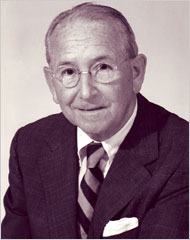http://www.nytimes.com/2008/01/10/science/10maclean.html?_r=0
Dr. Paul D. MacLean, a neuroscientist and psychiatrist who developed the intriguing theory of the “triune brain” to explain its evolution and to try to reconcile rational human behavior with its more primal and violent side, died on Dec. 26 in Potomac, Md. He was 94.
Dr. MacLean’s death was confirmed by his family.
In the late 1940s, while he was a young researcher at Yale, Dr. MacLean became interested in the brain’s control of emotion and behavior. After initial studies of brain activity in epileptic patients, he turned to cats, monkeys and other models, using electrodes to stimulate different parts of the brain in conscious animals. He then recorded the animals’ responses and, in the 1950s, began to trace individual behaviors like aggression and sexual arousal to their physiological sources.
Dr. MacLean (pronounced mac-LANE) termed the brain’s center of emotions the limbic system, and described an area that includes structures called the hippocampus and amygdala. Developing observations made by Dr. James W. Papez of Cornell, he proposed that the limbic system had evolved in early mammals to control fight-or-flight responses and react to both emotionally pleasurable and painful sensations. The concept is now broadly accepted in neuroscience.
Photo
Dr. MacLean said that the idea of the limbic system leads to a recognition that its presence “represents the history of the evolution of mammals and their distinctive family way of life.”
In the 1960s, Dr. MacLean enlarged his theory to address the human brain’s overall structure and divided its evolution into three parts, an idea that he termed the triune brain. In addition to identifying the limbic system, he pointed to a more primitive brain called the R-complex, related to reptiles, which controls basic functions like muscle movement and breathing. The third part, the neocortex, controls speech and reasoning and is the most recent evolutionary arrival.
In Dr. MacLean’s theory, all three systems remain in place and in frequent competition; indeed, their conflicts help explain extremes in human behavior.
In the 1970s and ’80s, aspects of Dr. MacLean’s model were popularized by the astronomer Carl Sagan and the novelist Arthur Koestler.
The triune brain theory remains controversial. Dr. Thomas R. Insel, a neuroscientist and director of the National Institute of Mental Health in Rockville, Md., said the theory was “outside the mainstream of scientific effort,” but added that Dr. MacLean’s research had opened the door for neuroscience to “ask big questions about consciousness and philosophy, instead of the more tractable questions about vision and movement.”
Paul Donald MacLean was born in Phelps, N.Y. He graduated from the Taft School and Yale, where he also earned his medical degree in 1940.
Dr. MacLean was named an assistant professor of psychiatry at Yale in 1951. He later became an associate professor of physiology there before moving to the National Institute of Mental Health in 1957. At the institute, he was chief of the Laboratory of Brain Evolution and Behavior in Poolesville, Md., and retired in the early 1990s.
In 1990, Dr. MacLean explained his theory in a book intended for specialists, “The Triune Brain in Evolution: Role in Paleocerebral Functions.”
Dr. MacLean’s wife of 64 years, the former Alison Stokes, died in 2006. The couple lived in Mitchellville, Md., and on Grindstone Island, near Clayton, N.Y.
He is survived by a daughter, Alison Cassidy of Potomac; four sons, Alexander, of Lincoln, Mass.; David, an endocrinologist, of Middletown, R.I.; James, of Rockville, Md.; and Paul Jr., of York, N.Y.; a brother, the Rev. Burton MacLean of Pomfret, Conn.; and 13 grandchildren.
Writing in The New York Times in 1971 and surveying the problem of intolerance and violence worldwide, Dr. MacLean found that “language barriers among nations present great obstacles.”
“But the greatest language barrier,” he concluded, “lies between man and his animal brains; the neural machinery does not exist for intercommunication in verbal terms.”